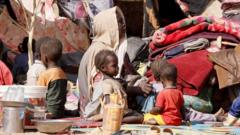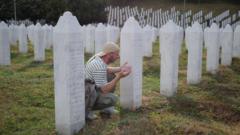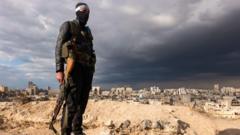In Baniyas, Syria, a recent sectarian attack has claimed over 1,600 lives, predominantly from the Alawite minority, underscoring the persistent instability in the region despite the recent establishment of a rebel-led government. The local authority's apparent failure to safeguard its citizens has escalated fears of a return to widespread violence.
Baniyas: A Grim Snapshot of Syria’s Continued Turmoil

Baniyas: A Grim Snapshot of Syria’s Continued Turmoil
The city of Baniyas, recently victim to a surge in sectarian violence, reveals the fragility of peace in post-civil war Syria as citizens mourn the loss of their loved ones amid an ongoing security crisis.
In early March, the coastal city of Baniyas became the scene of extreme violence, marking a stark reminder of Syria's ongoing struggles nearly 14 years post-civil war. Described as nearly abandoned, the streets bore the scars of conflict remnants—burned-out cars, shattered shop windows, and damaged structures revealing only charred walls. Local emergency workers had resorted to repurposing a looted furniture store as a temporary morgue, filled with body bags containing victims of a recent brutal attack.
Residents reported that a surge of armed men stormed the streets, leading to widespread fears as gunmen executed civilians indiscriminately. Within just three days, more than 1,600 lives were lost, primarily affecting the Alawite demographic that once enjoyed preferential treatment under Assad's regime. Eyewitness accounts depicted a harrowing scene: desperate families pleading for help to retrieve their deceased relatives as the crisis unfolded.
The violence was not merely an isolated event but a severe indication of the prevailing sectarian tensions and a glaring failure on behalf of the newly-established rebel-led government to protect the Alawite population. Local sources compiled incidents highlighting the government's inability to maintain order and respond effectively, further perpetuating a cycle of fear and retribution in a city that had hoped for better governance and stability.
This episode marks a significant setback for a region already teetering on the edge, devoid of comprehensive security and support mechanisms, and poses serious questions about the future of peace in Syria. As the memories of lost lives linger in the scorched reminders of Baniyas, the challenge remains not only to restore order but to address the deeply entrenched divisions that continue to threaten the fragile peace.
Residents reported that a surge of armed men stormed the streets, leading to widespread fears as gunmen executed civilians indiscriminately. Within just three days, more than 1,600 lives were lost, primarily affecting the Alawite demographic that once enjoyed preferential treatment under Assad's regime. Eyewitness accounts depicted a harrowing scene: desperate families pleading for help to retrieve their deceased relatives as the crisis unfolded.
The violence was not merely an isolated event but a severe indication of the prevailing sectarian tensions and a glaring failure on behalf of the newly-established rebel-led government to protect the Alawite population. Local sources compiled incidents highlighting the government's inability to maintain order and respond effectively, further perpetuating a cycle of fear and retribution in a city that had hoped for better governance and stability.
This episode marks a significant setback for a region already teetering on the edge, devoid of comprehensive security and support mechanisms, and poses serious questions about the future of peace in Syria. As the memories of lost lives linger in the scorched reminders of Baniyas, the challenge remains not only to restore order but to address the deeply entrenched divisions that continue to threaten the fragile peace.




















